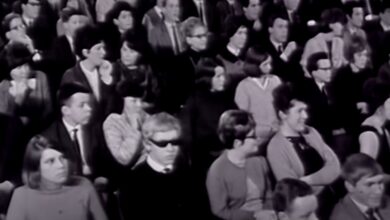The Supremes’ “You Can’t Hurry Love” – A 1966 Classic That Defined Motown’s Golden Era
When The Supremes released “You Can’t Hurry Love” in the summer of 1966, the song quickly became one of the defining anthems of Motown’s golden age. With its infectious melody, polished production, and uplifting message, the track not only captured the essence of the era but also showcased the remarkable evolution of The Supremes as a dominant force in pop and R&B music. The song became an instant hit, reaching No. 1 on the Billboard Hot 100 chart and further solidifying The Supremes’ status as one of the most successful girl groups of all time.
By the mid-1960s, The Supremes had emerged as Motown’s premier act, a trio that transcended racial barriers and redefined the sound of mainstream pop. Comprising Diana Ross, Mary Wilson, and Florence Ballard, the group had already achieved monumental success with hits like “Where Did Our Love Go” and “Baby Love.” Under the visionary leadership of Berry Gordy, Motown’s founder, and the expert craftsmanship of the label’s songwriting and production team, The Supremes consistently delivered chart-topping hits that combined catchy melodies with sophisticated vocal arrangements.
The inspiration for “You Can’t Hurry Love” came from a gospel influence deeply rooted in Motown’s musical foundation. The songwriting powerhouse of Holland-Dozier-Holland—comprising Brian Holland, Lamont Dozier, and Eddie Holland—crafted the song’s lyrics around a theme of patience and perseverance in love. Inspired by the gospel standard “(You Can’t Hurry God) He’s Right on Time,” the track carried an uplifting message that resonated with listeners, reinforcing the idea that good things come to those who wait.
Recorded at Motown’s legendary Hitsville U.S.A. studio in Detroit, the song featured the signature production elements that defined the label’s success. The Funk Brothers, Motown’s house band, laid down a vibrant, driving rhythm section, complete with a bouncing bassline from James Jamerson and dynamic drum patterns. Diana Ross’s lead vocal performance was delivered with a sense of urgency yet maintained the elegance that had become her hallmark. The backing harmonies from Wilson and Ballard provided a rich, layered sound that added depth to the track’s composition.
Upon its release in July 1966, “You Can’t Hurry Love” received widespread acclaim from critics and audiences alike. It became The Supremes’ seventh No. 1 hit on the Billboard Hot 100 and also topped the R&B chart. The song’s irresistible groove and positive message made it a favorite among radio stations, further extending its reach across diverse audiences. Internationally, it performed well in markets such as the UK, where it peaked at No. 3 on the singles chart.
Beyond its commercial success, the song played a crucial role in shaping the perception of Motown as a dominant force in the music industry. It reinforced the label’s ability to produce timeless, universally appealing songs that bridged racial and cultural divides. “You Can’t Hurry Love” became an anthem of optimism and resilience, a testament to the power of music in conveying messages of hope and perseverance.
For The Supremes, the song marked yet another high point in their career, proving their ability to evolve and stay relevant in an ever-changing musical landscape. The group continued to thrive with a string of successful releases, and Diana Ross’s prominence as a leading vocalist became more pronounced. The track’s success also contributed to Motown’s reputation as a hit-making machine, further cementing the label’s dominance in the 1960s.
The song’s influence extended far beyond its initial release. It became a reference point for future artists, inspiring generations of musicians across multiple genres. Elements of its composition—its brisk tempo, call-and-response structure, and uplifting lyrics—can be seen in later pop and R&B hits. The track’s legacy is especially evident in how it has been covered and reimagined over the decades.
One of the most notable covers of “You Can’t Hurry Love” came from British pop star Phil Collins in 1982. His rendition paid homage to the original while incorporating his signature production style, complete with crisp drum machines and a polished arrangement. Collins’s version was a major success, reaching No. 1 in the UK and No. 10 on the Billboard Hot 100. Other artists, including The Stray Cats and Dixie Chicks, have also recorded their own takes on the song, further proving its enduring appeal.
At the time of its release, The Supremes were at the height of their popularity, but the group also faced internal challenges. Florence Ballard, one of the original members, was beginning to experience personal and professional struggles that would later lead to her departure from the group. Despite this, “You Can’t Hurry Love” became a defining moment in their career, capturing the trio’s chemistry and showcasing the seamless artistry of Motown’s production team.
Over the decades, the song has remained a staple in classic pop and R&B radio playlists. It has been featured in films, television shows, and commercials, ensuring that new generations continue to discover and appreciate its magic. The track’s ability to evoke nostalgia while still feeling fresh is a testament to its masterful songwriting and timeless quality.
“You Can’t Hurry Love” also contributed to the evolution of soul and pop music by setting a high standard for future Motown releases. Its influence can be heard in the works of later artists who sought to blend pop sensibilities with the emotional depth of R&B. The song’s production techniques, particularly its use of layered instrumentation and rhythmic drive, paved the way for many of the hits that followed in the late 1960s and beyond.
While The Supremes eventually saw lineup changes and Diana Ross embarked on a highly successful solo career, their legacy remained intact. The group’s contributions to music history were formally recognized with their induction into the Rock and Roll Hall of Fame in 1988. “You Can’t Hurry Love” continues to be one of their most celebrated songs, standing as a reminder of the joy and inspiration that Motown brought to millions of fans worldwide.
Even today, the song’s message of patience and faith in love resonates with listeners. Whether experienced through the original recording or one of its many reinterpretations, “You Can’t Hurry Love” remains a quintessential example of Motown’s golden touch. More than half a century after its release, it still captures the essence of timeless pop music—joyful, heartfelt, and utterly unforgettable.



